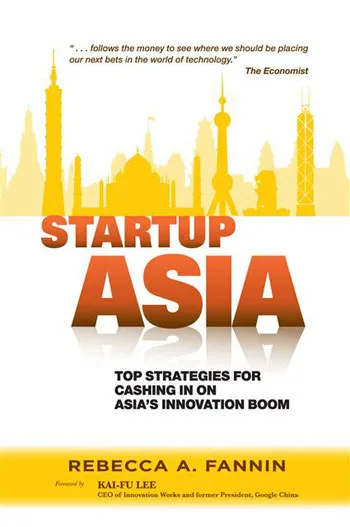[Book Review] Startup Asia: Top Strategies for Cashing in on Asia’s Innovation Boom
Monday May 06, 2013 , 6 min Read
by Rebecca Fannin
2012 John Wiley Asia, Singapore (http://rebeccafannin.com/)

Startup Asia is a good regional introduction to the startup buzz in China, India, Vietnam and Singapore – but the title of the book is misleading, there is no coverage at all of startups in other countries of Asia such as Japan and Korea, or Malaysia and Indonesia.
Rebecca A. Fannin (http://rebeccafannin.com/) is an international business journalist, speaker and consultant, whose previous book is Silicon Dragon (McGraw-Hill, 2008). She runs the consulting group Silicon Dragon Ventures (www.silicondragonventures.com), and has been a contributor to Forbes, Advertising Age, Fast Company, Wired, Worth, Asia Inc. and AsiaWeek.
Her book “Startup Asia” is based on dozens of interviews conducted over 18 months with entrepreneurs and investors in the region. Most of the startups interviewed are portfolio companies of only a few venture capital firms, so the coverage is a bit skewed. But for a single-handedly compiled entrepreneurial travelogue, the book is an easy read and a good overview of larger dynamics in the region.
The new generation of entrepreneurs in China and India are no longer looking to the West for their cues, but are instead crafting their own local business models and success strategies, according to Fannin.
Investors around the world need to be paying attention to the ‘VIC countries’ -- Vietnam, India and China – in sectors such as mobile, e-commerce, gaming, social networks, biomedical science and cleantech. In addition to the success stories of entrepreneurs who have made it big, the book also highlights the risks of doing business in Asia's developing markets, such as lack of intellectual property protection, political and regulatory shifts, bribery, and corruption.
The US, China and India are the top three venture capital investment markets in the world. Asian venture capital investment has tripled from 2005 to 2010, with much faster growth than the US, though the US is still the font of venture capital. Asian startups and investors also have strong connections to Silicon Valley, with many ‘returnees’ joining the entrepreneurial boom back home.
I have summarised some of the regional comparisons in Table 1; the individual chapters have more details of investment trends and profiles of key players.
Table 1: Asian Startup Hotspots
China has a new assertiveness, a “we own the world” mentality. “Grassroots entrepreneurship is at a higher level of sophistication than with the Web 1.0 generation,” observes Fannin. The first wave of startups in the 1990s featured portals Sina, Sohu and Netease, followed by the second wave (e-commerce giants Alibaba, Tencent, Shanda, Baidu) – the third wave features social networking powerhouses.
Government blocking of US sites like Facebook and Twitter has spawned home-grown versions of these services. Many of the earlier larger firms are launching their own versions of social sites.
Leading IPOs in the US by startups from China include Renren, Qihoo, Youku, ChinaCache and Taomee. Though venture investing in China is less than a decade old, it is going through the “growing-pain years” very quickly.
India has the promise to close the gap with China in terms of infrastructure, IT penetration, and venture funds, but has proven its edge in outsourcing and R&D, with a vibrant startup culture emerging in products. “India’s startups have the chance of going global more readily than do China’s emerging businesses, owing to the commonality of the English language and Westernised concepts that filter in uncensored,” Fannin explains.
But Indian businesses can list overseas only after first going public on domestic exchanges, unless they are set up with an offshore holding structure, eg. Mauritius, Cayman Islands. Strategic sales are more common than IPOs among venture-backed tech companies in India than China (eg. Pearson and TutorVista).
Vietnam is a new startup frontier in Asia, and is learning not just from entrepreneur models in the US but neighbouring China as well. The Vietnam startup ecosystem is about where China was 10 years ago. Vietnam’s online gaming industry exceeds that of India.
Singapore has the most advanced government-supported ecosystem for tech entrepreneurship – but there are sometimes gaps and delays in execution of startup support schemes.
One chapter each is devoted to emerging Asian startups in four key categories:
1. Cleantech: Attero Recycling, d.Light, Kotak Urja, Reva (India), SemiLEDs (Taiwan), LatticePower (China)
2. Consumer services: RedBaby, eHi Auto Services (China), KaatiZone (India)
3. Outsourcing: MindTree (India), Neusoft, VanceInfo, iSoftStone (China)
4. Breakthrough innovations: Robhotah Robotics, 3DSoc (India), Bubble Motion (Singapore).
Though many new successful startups in Asia are based on clones of US models (summarised in Table 2), they are ‘micro-innovating’ and adding new features faster than the original versions, eg. China’s Wibao layered in video and photo sharing before Twitter did; Ushi has added networking parties and mobile check-in for conferences on its LinkedIn-like site; Hudong has added advertisements and knowledge clubs to its Wikipedia clone.
Table 2: Asian Startup Clones
The book has informative interviews with many investors and entrepreneurs, covering their track record and serial startup careers. Numerous tables are also included, drawing from sources such as Bloomberg, NASDAQ, Zero2IPO, IDG, AVCJ and WIPO. A range of strategies is described for overseas investors to get into the Asia game. For example, the IDG Group gets its research insights into Asian startups from its publishing group, and then invests from venture shops in China, India and Vietnam.
The concluding chapter compares the IPO track record of Chinese and Indian startups. Listing is not a means to an end, but only a means of business development, experts caution. Timing and luck are key success factors as well.
In sum, there is a major growth in the “entrepreneurial and inventive muscle” of Asia. This may be a challenge to US leadership in startups, but also opens the door to new models of co-creation and investment. Asia still lacks, however, in truly disruptive innovation and in top-rated educational systems with strong startup ecosystem support.
“Technology advancements are making ideas travel faster and farther than ever before. Sometimes tech products from Asia are even more advanced than those in the West,” Fannin concludes. In the coming years, “made in Asia” will increasingly become “invented in Asia.”
[Follow YourStory's research director Madanmohan Rao on http://twitter.com/MadanRao]








